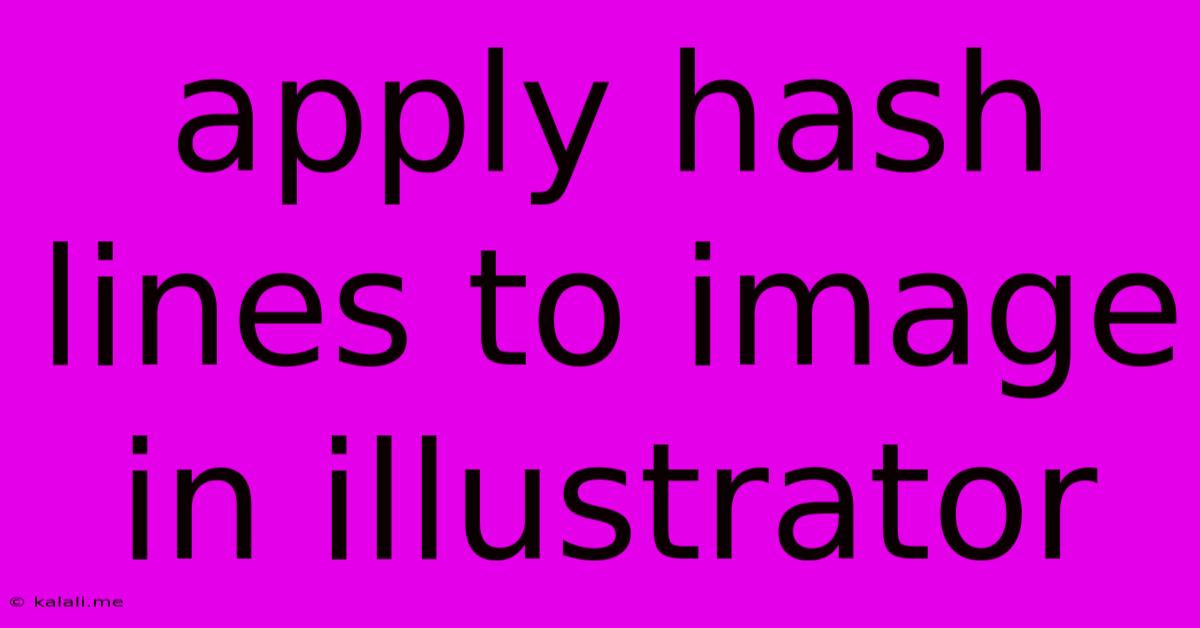Apply Hash Lines To Image In Illustrator
Kalali
Jun 05, 2025 · 4 min read

Table of Contents
Applying Hash Lines to Images in Illustrator: A Comprehensive Guide
This article provides a comprehensive guide on how to effectively apply hash lines, also known as crosshatch lines or hatching, to images in Adobe Illustrator. We'll cover several methods, from simple techniques for quick results to more advanced approaches for intricate control. Learn how to create a unique visual style, enhancing your images with texture and depth.
Why Use Hash Lines in Illustrator?
Hash lines are a powerful tool for adding visual interest and texture to your illustrations. They can:
- Create a sense of depth and dimension: Hash lines can mimic shading and shadow, adding realism to your images.
- Improve readability: In some cases, applying hash lines can make elements of a complex image easier to distinguish.
- Establish a specific style: Hash lines can contribute to a distinct artistic style, from technical drawings to comic book art.
- Add visual weight and emphasis: Strategically placed hash lines can draw the viewer's eye to certain areas.
Methods for Applying Hash Lines in Illustrator
Several techniques exist for creating hash line effects in Illustrator. Here are some of the most effective:
1. Using the Blend Tool for Simple Hash Lines
This is the easiest method for creating basic hash lines.
- Draw your lines: Create parallel lines using the Line Segment Tool () at your desired spacing and angle.
- Duplicate and rotate: Duplicate the lines and rotate them 90 degrees.
- Select both sets of lines: Select both sets of horizontal and vertical lines.
- Apply the Blend Tool: Go to
Object > Blend > Make. Experiment with theSpecified Stepsoption in theBlend Optionspanel to adjust the line density.
This method works well for simple, evenly spaced hash lines.
2. Utilizing the Pattern Swatches for More Complex Hash Lines
This method offers greater control and allows for creating more complex hash line patterns.
- Create a basic hash line unit: Create a small square or rectangle with intersecting lines to form your desired hash line pattern.
- Create a new pattern swatch: Go to
Edit > Define Patternand name your swatch. - Apply the pattern swatch: Select your image, and in the
Swatchespanel, apply the newly created pattern swatch. You can adjust the scale of the pattern as needed.
This allows you to reuse the same hash line pattern across multiple images and projects.
3. Using the Appearance Panel for Advanced Control
For the most intricate control over your hash lines, leverage the power of the Appearance panel.
- Create a clipping mask: Place your image within a clipping mask (select image and shape, then
Object > Clipping Mask > Make). - Add a hash line pattern: Add a pattern swatch (as described above) or multiple lines within the clipping mask.
- Adjust opacity and blending modes: In the Appearance panel, experiment with opacity and blending modes to refine the effect and integrate it seamlessly with your original image. This allows for creating subtle or highly pronounced hash line effects.
This method gives you unparalleled flexibility, enabling you to achieve realistic shading or artistic effects.
4. Utilizing Image Tracing for Converting Photographs
If you're working with a photograph, Illustrator's image tracing feature can be incredibly useful.
- Import your photograph: Place your image into your Illustrator document.
- Trace the image: Go to
Image Traceand adjust the settings to create a vectorized version of your image. Experiment with different settings, prioritizing high detail to ensure the quality of the tracing. This gives you a vector graphic you can edit. - Convert to a black and white image: Use the Image Trace options to make a black and white version. This creates the base for the hatch lines.
- Apply the hash lines: Once you have a suitable black and white tracing, you can use the methods mentioned above to apply the hash lines to create a distinct look.
This process is ideal for turning photos into stylized illustrations with a unique hatched effect.
Conclusion
Applying hash lines in Illustrator offers diverse ways to enhance images and achieve unique stylistic effects. By mastering these techniques, you can add depth, texture, and visual interest to your designs, creating captivating illustrations. Remember to experiment with different line weights, spacing, and angles to discover what works best for your specific projects. Remember to save your work frequently!
Latest Posts
Latest Posts
-
Are We All Descendants From Noah
Jun 06, 2025
-
How To Wire A Ceiling Fan With Remote
Jun 06, 2025
-
American Cant Check In Put Names Together
Jun 06, 2025
-
I Am Sorry To Hear That
Jun 06, 2025
-
Fnv Dead Money How To Turn Off Doors
Jun 06, 2025
Related Post
Thank you for visiting our website which covers about Apply Hash Lines To Image In Illustrator . We hope the information provided has been useful to you. Feel free to contact us if you have any questions or need further assistance. See you next time and don't miss to bookmark.